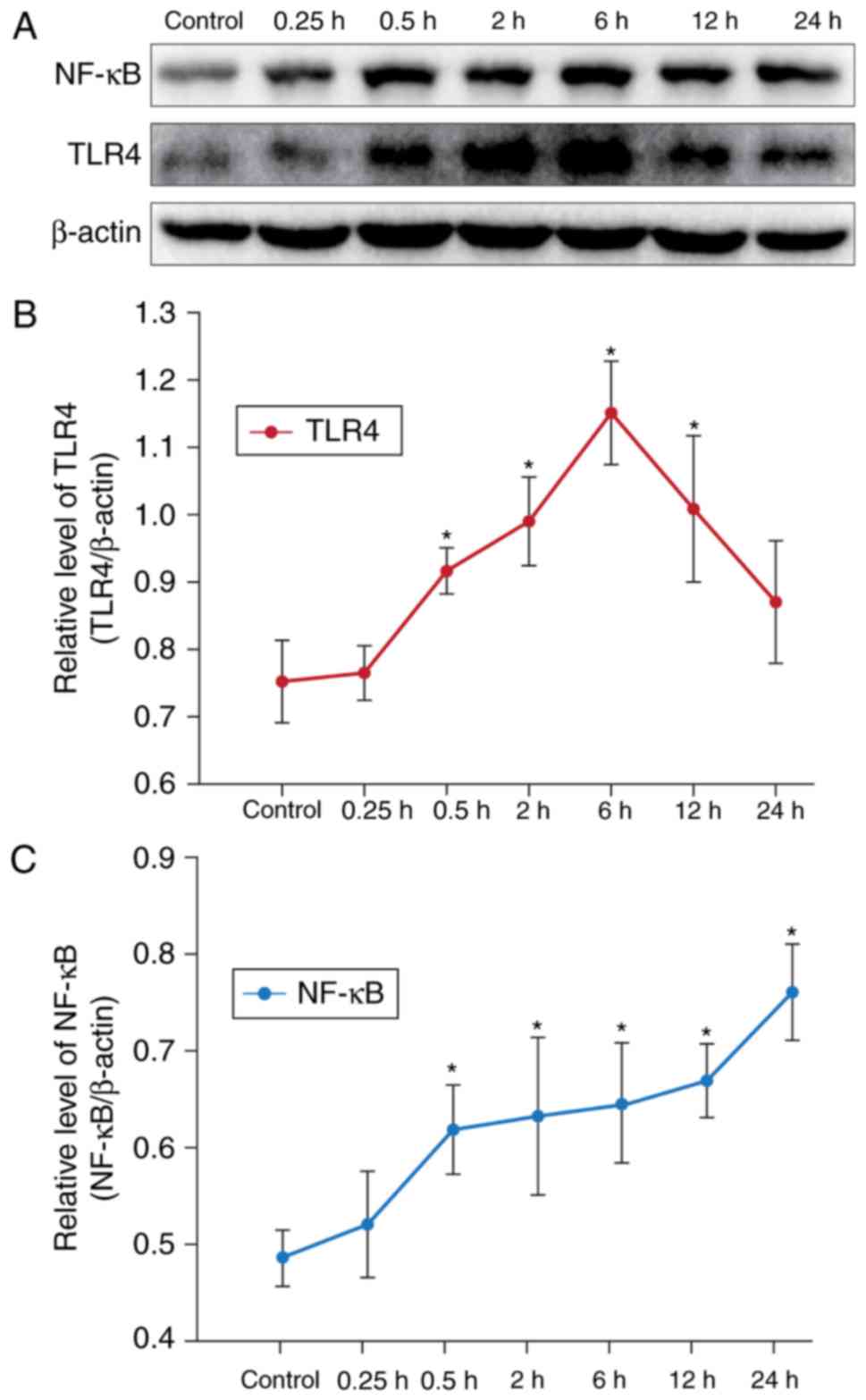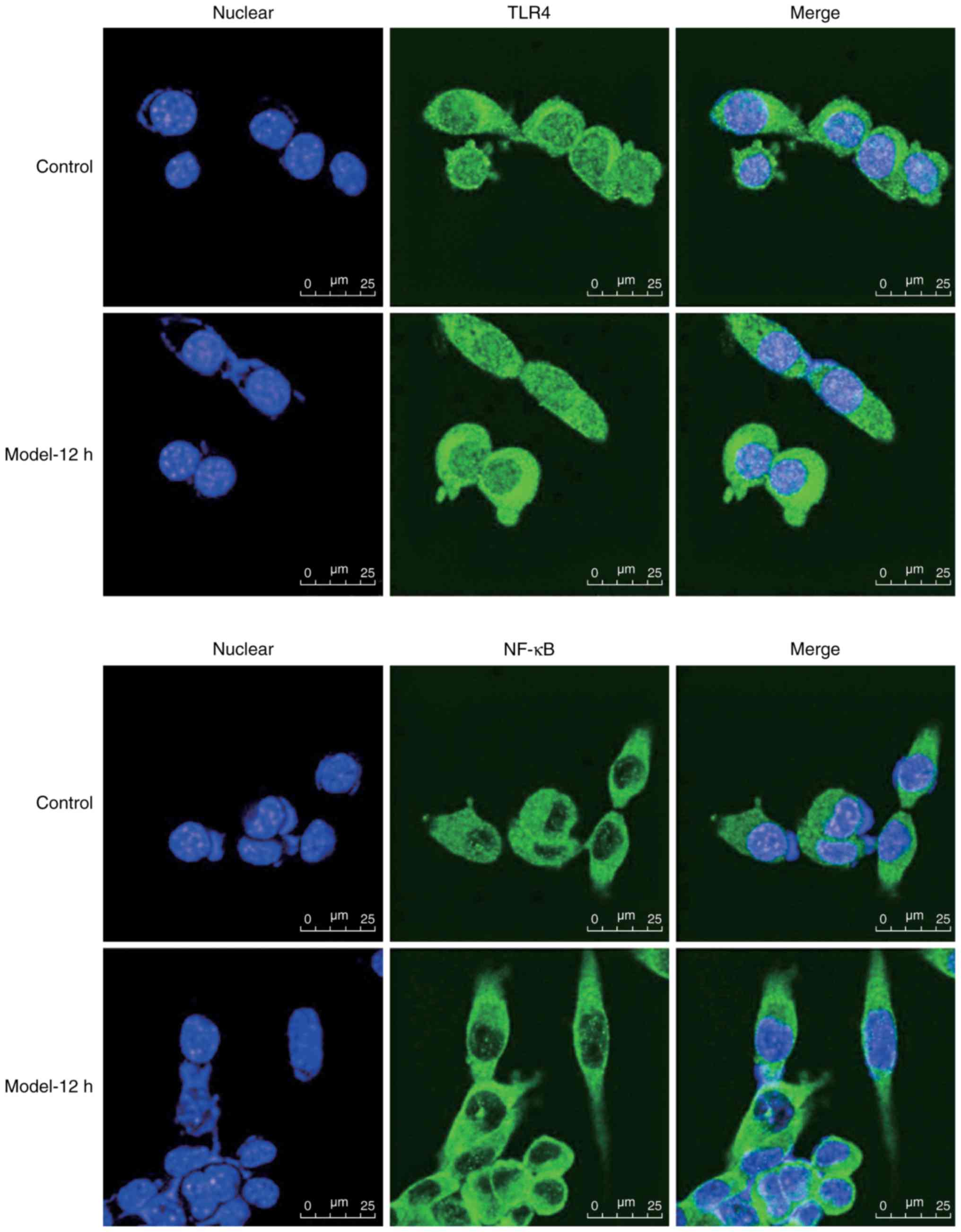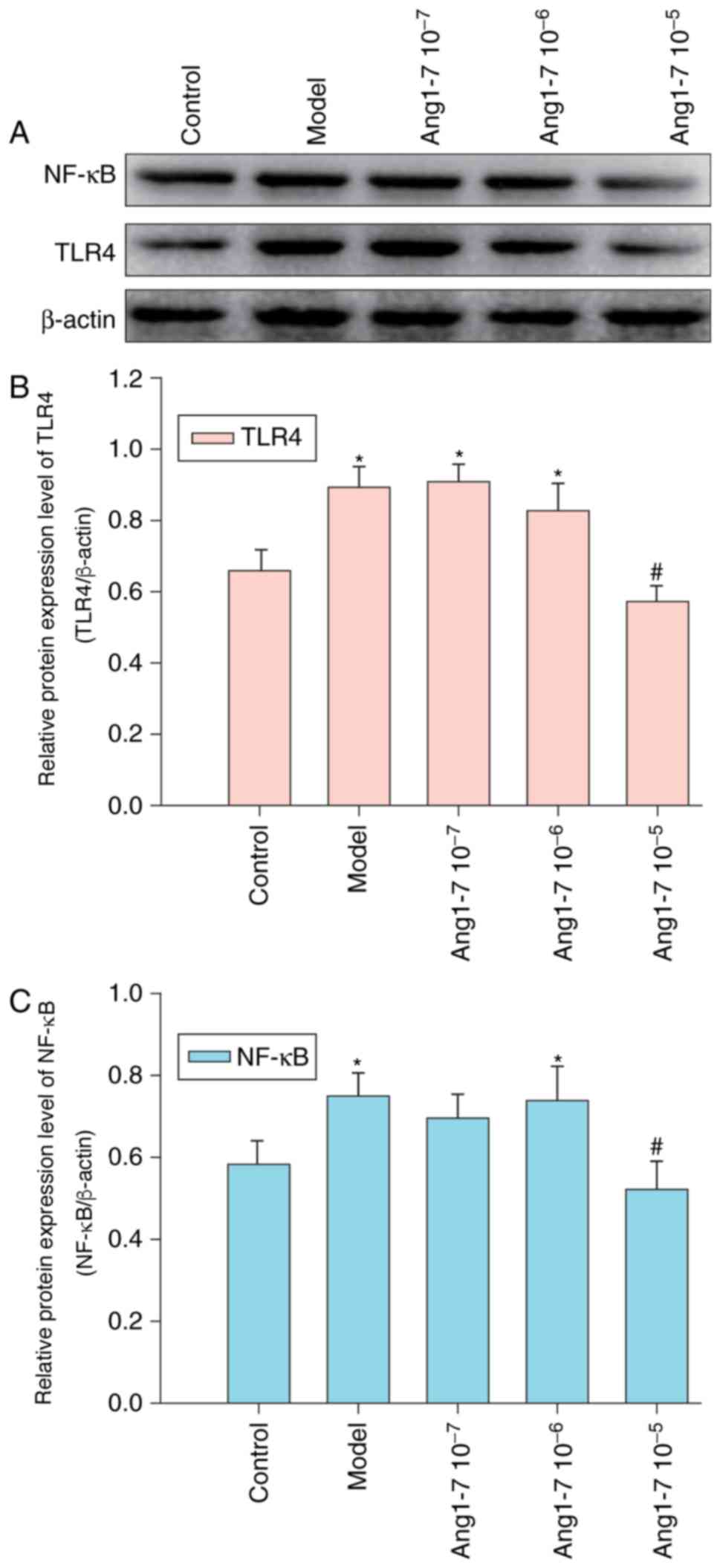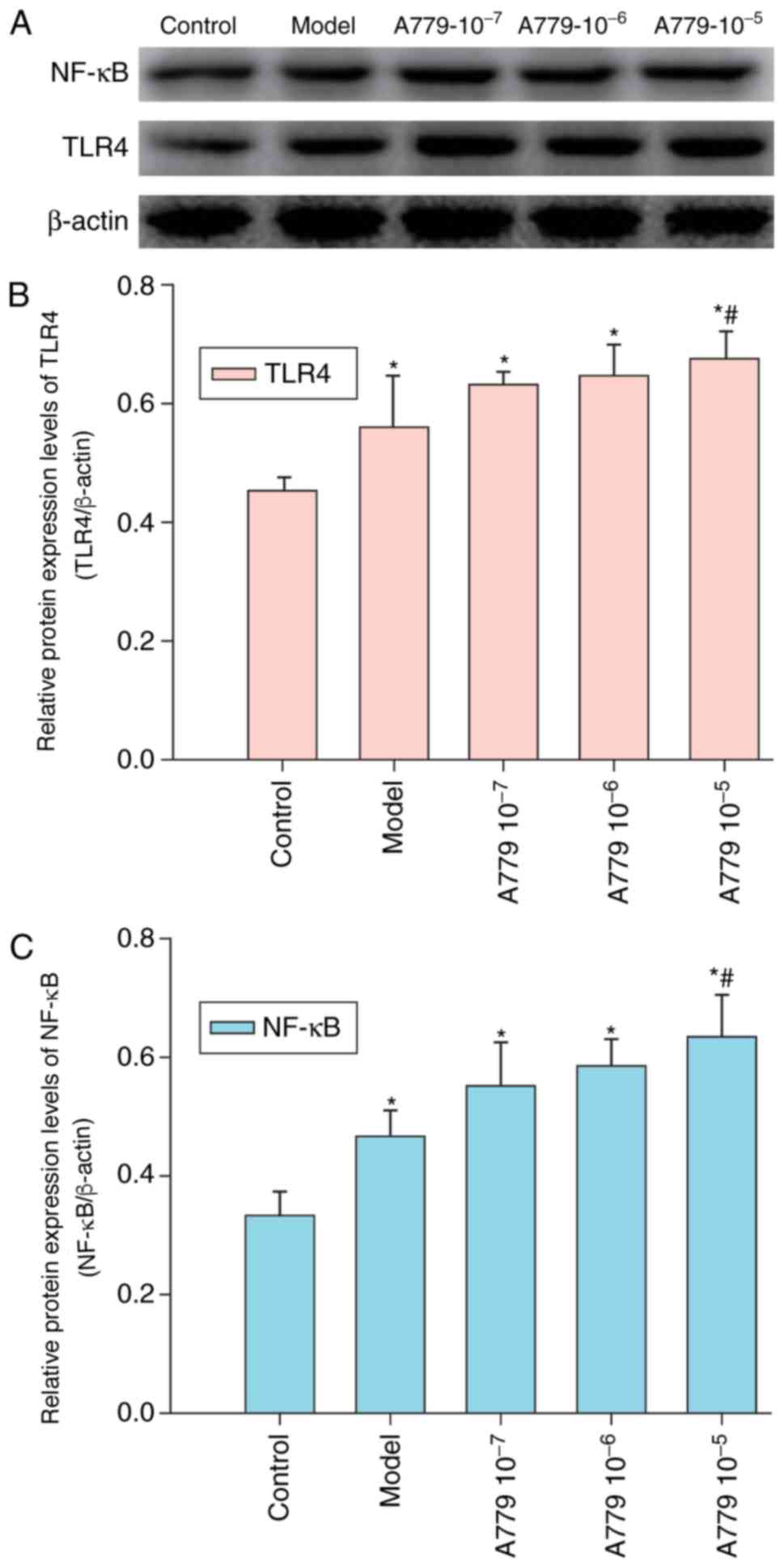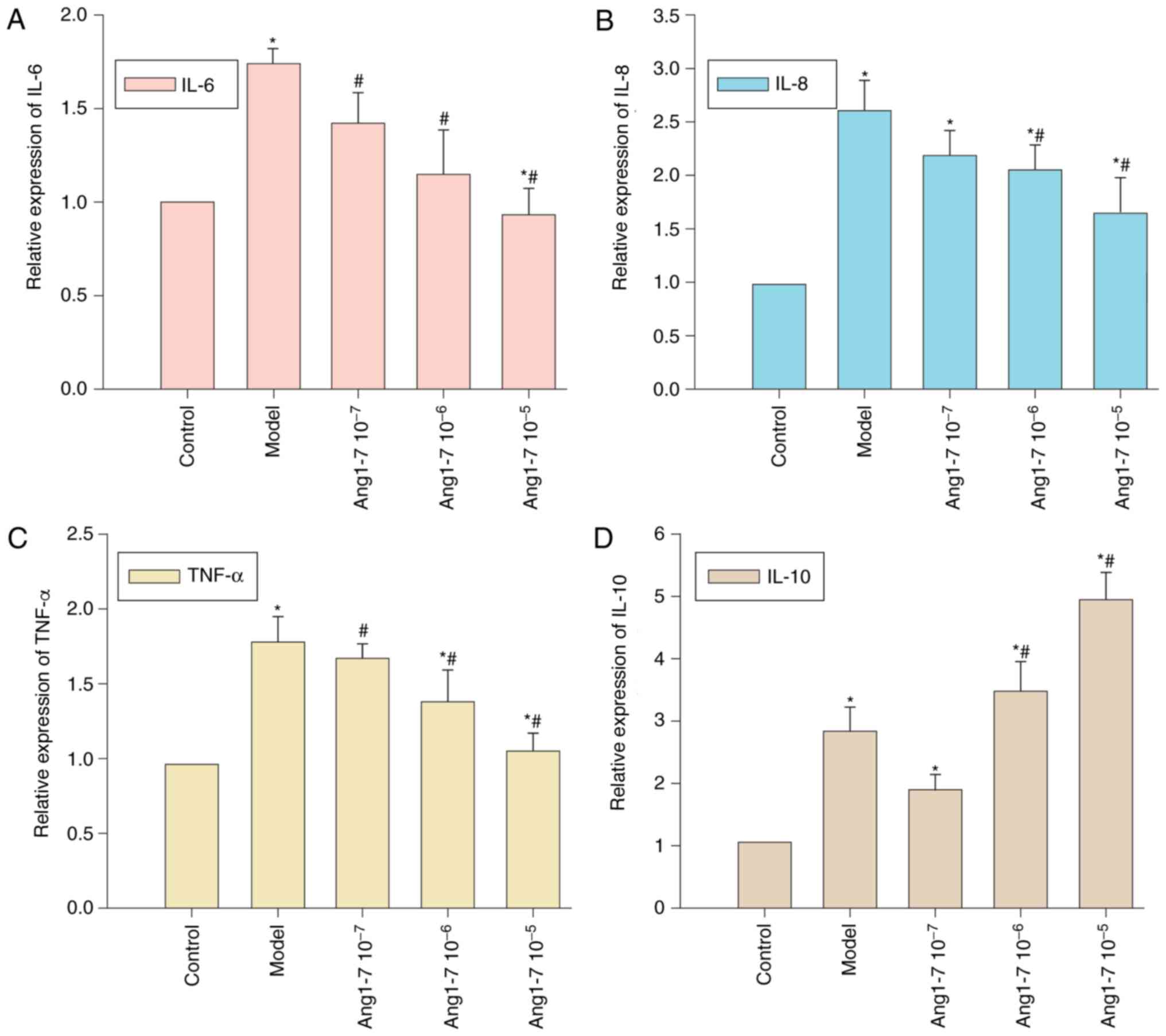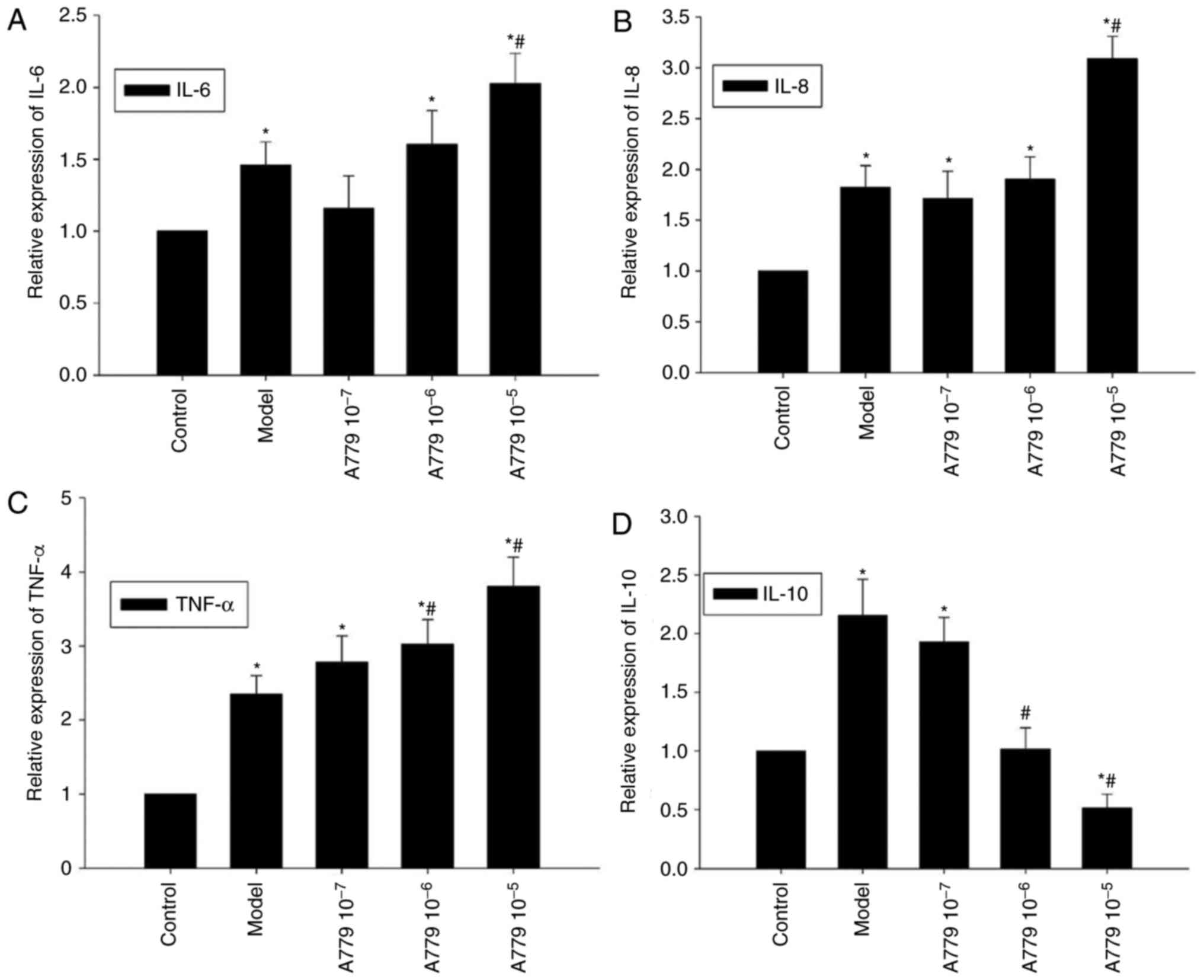Angiotensin 1-7 ameliorates caerulein-induced inflammation in pancreatic acinar cells by downregulating Toll-like receptor 4/nuclear factor-κB expression
- Authors:
- Published online on: December 27, 2017 https://doi.org/10.3892/mmr.2017.8354
- Pages: 3511-3518
-
Copyright: © Wang et al. This is an open access article distributed under the terms of Creative Commons Attribution License.
Abstract
Introduction
The renin-angiotensin system (RAS) has been implicated in the pathophysiology of pancreatitis (1). Evidently, high levels of angiotensin I converting enzyme 2 (ACE2), angiotensin (Ang) 1–7, and its corresponding receptor Mas, expression are detected in plasma and in the pancreas of mice with acute pancreatitis (AP). These factors serve protective roles during the pathogenesis of pancreatitis within mice (2). Ang 1–7 has been reported to serve as an endogenous antagonist of Ang II, possessing anti-inflammatory and vasodilatory activities, and exerting protective effects against endothelial injury (3–5). Our previous study revealed that caerulein (CAE) can stimulate the ACE2-Ang-1-7-Mas axis and significantly inhibit pancreatitis development via endothelial nitric oxide synthase activation and nitric oxide signaling within AR42J cells (6). In addition, further study identified that in the AR42J cells stimulated by CAE, blocking of Mas receptor using A779, then enhancement of Ang (1–7), still can reduce the inflammatory response. It is therefore hypothesized that Ang (1–7) has other anti-inflammatory pathways besides the Mas receptor pathway; however, further investigation is required.
Toll-like receptors (TLRs) are required for the onset of inflammation, and can initiate inflammatory signaling (7). TLR4 is a member of the TLR family and is expressed by pancreatic macrophages, acinar cells and stellate cells (8). Engagement of TLR4 with its ligands, such as lipopolysaccharide, can activate the nuclear factor (NF)-κB signaling pathway and induce the expression of tumor necrosis factor-α (TNF-α), and other proinflammatory cytokines that lead to pancreatic inflammation (9–12). During the pathogenesis of AP, the RAS also regulates the NF-κB signaling pathway and cytokine production, which contributes to the pathogenesis of AP (13). Our previous study reported the expression of Ang 1–7 within AR42J cells; high levels of circulating Ang 1–7 were detected within mice with severe AP (SAP) (2). However, it is unclear whether endogenous and exogenous Ang 1–7 can regulate TLR4 and NF-κB expression within AR42J cells during the inflammatory process. In the present study, a cellular model was employed to investigate the effect of Ang 1–7 on the expression of TLR4, NF-κB and inflammatory cytokines within AR42J cells.
Materials and methods
Cell culture and grouping
Rat pancreatic acinar AR42J cells [American Type Culture Collection (ATCC), Manassas, VA, USA] were cultured in F-12K medium (ATCC) containing 20% fetal bovine serum (Gibco; Thermo Fisher Scientific, Inc., Waltham, MA, USA), 100 U/ml penicillin and 100 µg/ml streptomycin (complete medium) at 37°C in a humidified atmosphere containing 5% CO2. Cells were stimulated with 10 nmol/l CAE (Sigma-Aldrich; Merck KGaA, Darmstadt, Germany) for 0.25, 0.5, 2, 6, 12 or 24 h to induce inflammation (14). All drug intervention group cells were stimulated at room temperature, and then incubated at 37°C in a humidified atmosphere containing 5% CO2. In addition, cells were treated with vehicle [F-12K medium containing 5% fetal bovine serum (Gibco; Thermo Fisher Scientific, Inc.)] alone (Control) or 10 nmol/l CAE for 12 h (Model). Some cells were pretreated with Ang 1–7 (10−7, 10−6 or 10−5 mol/l; Sigma-Aldrich; Merck KGaA) or Ang 1–7 antagonist A779 (10−7, 10−6 or 10−5 mol/l; Sigma-Aldrich; Merck KGaA) for 12 h and stimulated with 10 nmol/l CAE for 12 h. The groups of differentially treated cells were harvested for subsequent experimentation.
Immunofluorescence assay
Expression levels of TLR4 and NF-κB in the control and model cell groups were determined by immunofluorescence analysis. Briefly, cells of the control and model groups were harvested and washed in phosphate-buffered saline (pH 7.4), fixed in 4% (v/v) paraformaldehyde at 37°C for 40 min, and were then treated with 1% bovine serum albumin (Gibco; Thermo Fisher Scientific, Inc.) at 37°C for 30 min. The cells were incubated with rabbit anti-TLR4 (ab22048; 1:200; Abcam, Cambridge, UK) and anti-NF-κB p65 (8242; 1:200; Cell Signaling Technology, Inc., Danvers, MA, USA) or control rabbit immunoglobulin G (IgG; ab6730; 1:200; Abcam, Cambridge, UK) at 4°C overnight. Cells were washed and incubated with fluorescein isothiocyanate-conjugated goat anti-rabbit IgG (bs-0295M-FITC; 1:100; BIOSS, Beijing, China) for 40 min at 37°C followed by staining with DAPI (Santa Cruz Biotechnology, Inc., Dallas, TX, USA). The cells were examined under a fluorescent microscope and images were captured.
Western blotting
Harvested cells were lysed using lysis buffer (BIOSS, Beijing, China) and were centrifuged (25,155 × g for 15 min at 4°C). Following quantification of protein concentrations using a Bicinchoninic Acid Protein Assay kit (Pierce; Thermo Fisher Scientific, Inc., Waltham, MA, USA), cell lysate proteins (25 µg/lane) were separated by 10% SDS-PAGE and were transferred onto polyvinylidene fluoride membranes. The membranes were incubated with 5% non-fat dry milk in Tris-buffered saline containing 2% Tween at 37°C for 2 h and were then incubated with monoclonal rabbit anti-mouse TLR4 (ab22048; 1:800; Abcam), anti-β-actin (4970; 1:500; Cell Signaling Technology, Inc.), or anti-NF-κBp65 (8242; 1:800; Cell Signaling Technology, Inc.) at 4°C overnight. Membranes were washed and were incubated with peroxidase-conjugated goat anti-rabbit antibodies (sc-2004; 1:5,000; Santa Cruz Biotechnology, Inc.) for 1 h at 25°C and were visualized using enhanced chemiluminescence detection reagents (EMD Millipore, Billerica, MA, USA). The relative levels of target protein compared with β-actin were determined via densitometric analysis using Image software version 3.0 (Bio-Rad Laboratories, Inc., Hercules, CA, USA).
Reverse transcription-quantitative polymerase chain reaction (RT-qPCR)
Total RNA was extracted from different groups of cells using TRIzol reagent (Invitrogen; Thermo Fisher Scientific, Inc.,) and reverse transcribed into cDNA using the High Capacity cDNA Reverse Transcription kit (Fermentas; Thermo Fisher Scientific, Inc., Pittsburgh, PA, USA) according to the manufacturer's protocol. The resultant cDNA served as templates for RT-qPCR using the Power SYBR Green PCR Master Mix (Applied Biosystems; Thermo Fisher Scientific, Inc.) and specific primers in an Applied Biosystems 7500 fast platform (Applied Biosystems; Thermo Fisher Scientific, Inc.). The primer sequences were: IL-6 forward, 5′TGCCTTCTTGGGACTGAT3′ and reverse, 5′CTGGCTTTGTCTTTCTTGTTAT3′ (384 bp); IL-10 forward, 5′CCTGGTAGAAGTGATGCC3′ and reverse, 5′CACCTTTGTCTTGGAGCT3 (191 bp); IL-8 forward, 5′TCGTCCACGCCACAAGTA3′ and reverse, 5′CAGTAGTCCGAAGAATGAAG3′ (117 bp); TNF-α forward, 5′CCACGCTCTTCTGTCTACTG3′ and reverse, 5′GCTACGGGCTTGTCACTC3′ (145 bp); and GAPDH forward, 5′CTCAACTACATGGTCTACATGTTCCA-3′ and reverse, 5′-CTTCCCATTCTCAGCCTTGACT-3′ (81 bp). The qPCR reactions were performed in triplicate at 95°C for 10 min, 95°C for 15 sec, and 60°C for 1 min for 40 cycles. Data were normalized to GAPDH and analyzed by the 2−ΔΔCq method (15).
Statistical analysis
All cell experiments were repeated three times, and all data are expressed as the mean ± standard deviation. The difference among groups was determined by one-way analysis of variance followed by a Newman-Keuls test using the Statistical Package for Social Sciences software for Windows, version 16.0 (SPSS, Inc., Chicago, IL, USA). P<0.05 was considered to indicate a statistically significant difference.
Results
CAE enhances TLR4 and NF-κB expression in AR42J cells
In order to investigate the effects of CAE on TLR4 and NF-κB, AR42J cells were treated with or without 10 nmol/l CAE for various durations; TLR4 and NF-κB expression within AR42J cells was determined by western blotting (Fig. 1A). Compared with the control group, treatment with CAE for 0.5 h significantly increased the relative expression levels of TLR4 (Fig. 1B) and NF-κB (Fig. 1C) in AR42J cells (Fig. 1). The protein expression levels of TLR4 peaked after 6 h of CAE treatment, whereas CAE induced NF-κB expression in a time-dependent manner within AR42J cells. In our previous experiments, it was identified that the inflammatory response of AR42J cells was evident at 12 h, and the expression of TLR4 and NF-κB increased markedly at this time point. Therefore, treatment with CAE for 12 h was selected as the model of CAE-induced acute inflammation for subsequent experiments.
To further determine the effects of CAE on TLR4 and NF-κB, cells were treated with CAE or vehicle for 12 h, after which TLR4 and NF-κB expression levels were determined by immunofluorescence. As presented in Fig. 2, weak anti-TLR4 fluorescence within the membranes and cytoplasm, and weak anti-NF-κBp65 fluorescence in the cytoplasm and nuclei was detected within the AR42J control cells. Conversely, increased anti-TLR4 and anti-NF-κBp65 fluorescence was observed within the CAE-treated cells; anti-NF-κBp65 fluorescence was greater within the nuclei of CAE-treated cells. Collectively, these results indicated that CAE induced TLR4 and NF-κB expression within AR42J cells.
Treatment with Ang 1–7 abrogates CAE-induced TLR4 and NF-κB expression within AR42J cells
Ang 1–7 has been reported to exhibit anti-inflammatory activities; the effects of Ang 1–7 on CAE-induced inflammation were investigated within AR42J cells that were treated with or without various concentrations of Ang 1–7 and were stimulated with CAE for 12 h. Control cells were treated with vehicle alone. Relative protein expression levels of TLR4 and NF-κB were determined via western blot analysis (Fig. 3). CAE treatment was observed to significantly enhance TLR4 and NF-κB expression levels; however, pretreatment with Ang 1–7 (10−6 or 10−7 mol/l) failed to significantly modulate the effect of CAE on TLR4 and NF-κB expression. However, 10−5 mol/l Ang 1–7 significantly abrogated CAE-induced TLR4 and NF-κB expression within AR42J cells.
Treatment with Ang 1–7 specific antagonist A779 enhances CAE-induced TLR4 and NF-κB expression within AR42J cells
Our previous study demonstrated that Ang 1–7 and its receptor Mas are expressed within AR42J cells (6). The effect of A779 on CAE-induced TLR4 and NF-κB expression was investigated in AR42J cells pretreated with various concentrations of A779 followed by CAE treatment for 12 h. Relative expression levels of TLR4 and NF-κB were determined by western blot analysis. As presented in Fig. 4, treatment with A779 enhanced the expression levels of TLR4 and NF-κB within AR42J cells in a dose-dependent manner. Pretreatment with A779 (10−5 mol/l) significantly increased TLR4 and NF-κB expression compared with in the model group, in which cells were not pretreated with A779 for 12 h. These results suggested that the reduction of CAE-induced expression of TLR4 and NF-κB was enhanced by A779 with AR42J cells.
Treatment with Ang 1–7 or A779 modulates CAE-induced cytokine expression within AR42J cells
The effects exerted by Ang 1–7 and A779 on CAE-induced cytokine expression were investigated. AR42J cells were pretreated with Ang 1–7 and were stimulated with CAE for 12 h. The mRNA expression levels of IL-6, IL-8, TNF-α and IL-10 relative to GAPDH were detected using RT-qPCR. CAE treatment significantly enhanced IL-6, IL-8, TNF-α and IL-10 expression within AR42J cells (P<0.05, Fig. 5A-D). Pretreatment with Ang 1–7 decreased IL-6, IL-8 and TNF-α expression in a dose-dependent manner. A significant decrease in IL-6 and TNF-α expression was observed with all concentrations of Ang 1–7, whereas IL-8 expression was decreased following treatment with 10−6 and 10−5 mol/l Ang 1–7. Conversely, 10−6 and 10−5 mol/l Ang 1–7 pretreatment increased IL-10 expression. Therefore, the addition of exogenous Ang 1–7 was associated with a reduction in the expression of proinflammatory cytokines and an increase in anti-inflammatory IL-10 expression within AR42J cells.
RT-qPCR was employed to investigate whether the effects of endogenous Ang 1–7 on CAE-induced cytokine expression may be antagonized by A779 within AR42J cells. Compared with the model group, pretreatment with 10−5 mol/l A779 significantly increased CAE-induced expression of IL-6 and IL-8; CAE-induced expression of TNF-α expression within AR42J cells significantly increased with A779 pretreatment (10−6 and 10−5 mol/l; P<0.05, Fig. 6A-C). Conversely, the mRNA expression levels of IL-10 were decreased in response to A779 pretreatment, a significant decrease was observed with the addition of 10−6 and 10−5 mol/l A779, compared with in the control and model groups (P<0.05; Fig. 6D). Collectively, antagonism of endogenous Ang 1–7 via A779 significantly enhanced CAE-induced expression of proinflammatory cytokines and decreased the expression of anti-inflammatory IL-10 within AR42J cells.
Discussion
Ang II and its receptors AT1 and AT2 serve important roles in the pathogenesis of AP, whereas Ang 1–7 has been reported to act as an antagonist that inhibits inflammation (16,17). In addition, recent studies have demonstrated that Ang II can regulate TLR4 expression in order to modulate inflammation and other associated functions (18–20). In the present study, the effects of endogenous and exogenous Ang 1–7 on CAE-induced inflammation within AR42J cells were investigated. The purpose of the present study was to investigate the effect of Ang1-7 on TLR4/NF-κB and its possible anti-inflammatory mechanism by inhibiting TLR4 pathway, so the effect of ANG1-7 was blocked endogenously following the addition of the ANG1-7 antagonist A779. Endogenous blocking and exogenous increase of Ang1-7 was used to explore its role. The results revealed that CAE upregulated TLR4 and NF-κB expression; however, high doses of Ang 1–7 abrogated CAE-induced TLR4 and NF-κB expression in AR42J cells. Notably, Ang 1–7 is expressed within R42J cells following stimulation by CAE (6). The data of the present study indicated that endogenous Ang 1–7 may serve as a compensatory regulator to inhibit inflammation in an autocrine or paracrine manner during the inflammatory response in AP. This is supported by a previous report that Ang 1–7 inhibits the TLR4/NF-κB signaling pathway and ameliorates inflammation of the liver (21); therefore, Ang 1–7 may be considered an anti-inflammatory factor that serves to downregulate the TLR4/NF-κB signaling pathway during the pathogenic progression of AP. These novel findings suggested that Ang 1–7 may serve importance in the intervention of AP.
Pancreatitis has been recognized to be a result of the systemic inflammatory response which activate NF-κB and mitogen-activated protein kinases, which in turn regulate the expression of inflammatory cytokines, including IL-1β, IL-6, interleukin-8 and transforming growth factor-β1 in caerulein-stimulated pancreatic acinar cells (22). Engagement of TLR4 by its ligand can activate NF-κB and other pathways to stimulate proinflammatory IL-6, IL-8 and TNF-α production, which also upregulates anti-inflammatory IL-10 expression during the inflammatory process of AP (23–25). The findings of the present study demonstrated that CAE treatment significantly increased the relative expression levels of IL-6, IL-8, TNF-α and IL-10 within AR42J cells. A previous study demonstrated that pro-inflammatory cytokines, such as TNF-α and IL-6, were greatly increased, and the anti-inflammatory IL-10 was markedly decreased in the circulation after induction of SAP. The Ace2 KO mice exhibited increased levels of TNF-α, IL-1β, IL-6, multifocal coagulative necrosis and inflammatory infiltrate, and lower levels of serum IL-10 and pancreatic Ang-(1–7) compared with caerulein-treated WT mice at the same time point (1). Combined with the current research, these findings suggested that an imbalance between proinflammatory and anti-inflammatory cytokine responses is crucial for the pathogenesis of AP. In addition, treatment with exogenous Ang 1–7 reduced the CAE-induced IL-6, IL-8 and TNF-α expression, but increased IL-10 production in AR42J cells. Conversely, antagonism of Ang 1–7 exerted by A779 treatment increased CAE-induced expression of IL-6, IL-8 and TNF-α, and decreased IL-10 expression within AR42J cells. Additionally, endogenous and exogenous Ang 1–7 has been reported to modulate the imbalance between pro- and anti-inflammatory cytokine responses to limit inflammation during the pathogenesis of AP (26). A previous study suggested that inflammatory cytokines may be considered prognostic markers in the progression of SAP (27). The findings of the present study indicated that the imbalance between pro- and anti-inflammatory cytokine responses may serve importance in the evaluation of AP-associated inflammation reaction. Whether endogenous and exogenous Ang 1–7 can downregulate TLR4 and NF-κB expression, and alter the imbalance between pro- and anti-inflammatory cytokines, in vivo remains to be elucidated. In addition, the potential mechanisms underlying the effects of Ang 1–7 on TLR-4 and NF-κB expression during the progression of AP have yet to be investigated.
In conclusion, the results of the present study indicated that CAE induced the expression of TLR4 and NF-κB, as well as pro- and anti-inflammatory cytokines, within AR42J cells, which was downregulated by endogenous and exogenous Ang 1–7. These findings may provide novel insights into the pathophysiological mechanism of pancreatitis and provide a new target for the treatment of pancreatitis.
Acknowledgements
The authors of the present study would like to thank their colleagues and the expert panel members for their support and help. The present study was supported by grants from the National Natural Science Foundation of China (grant no. 81441060), the Research Foundation of Beijing Friendship Hospital, Capital Medical University (grant no. yyqdkt2014-4) and Beijing Municipal Administration of Hospitals' Youth Programme, (grant no. QML20150104).
Glossary
Abbreviations
Abbreviations:
|
Ang |
angiotensin |
|
CAE |
caerulein |
|
RAS |
renin-angiotensin system |
|
ACE2 |
angiotensin I converting enzyme 2 |
|
AP |
acute pancreatitis |
|
TLRs |
Toll-like receptors |
|
LPS |
lipopolysaccharide |
|
TNF-α |
tumor necrosis factor-α |
References
|
Liu R, Qi H, Wang J, Wang Y, Cui L, Wen Y and Yin C: Angiotensin-converting enzyme (ACE and ACE2) imbalance correlates with the severity of cerulein-induced acute pancreatitis in mice. Exp Physiol. 99:651–663. 2014. View Article : Google Scholar : PubMed/NCBI | |
|
Wang Y, Wang J, Liu R, Qi H, Wen Y, Sun F and Yin C: Severe acute pancreatitis is associated with upregulation of the ACE2-angiotensin-(1–7)-Mas axis and promotes increased circulating angiotensin-(1–7). Pancreatology. 12:451–457. 2012. View Article : Google Scholar : PubMed/NCBI | |
|
Mori J, Patel VB, Ramprasath T, Alrob OA, DesAulniers J, Scholey JW, Lopaschuk GD and Oudit GY: Angiotensin 1–7 mediates renoprotection against diabetic nephropathy by reducing oxidative stress, inflammation, and lipotoxicity. Am J Physiol Renal Physiol. 306:F812–F821. 2014. View Article : Google Scholar : PubMed/NCBI | |
|
Lu CL, Wang Y, Yuan L, Li Y and Li XY: The angiotensin-converting enzyme 2/angiotensin (1–7)/Mas axis protects the function of pancreatic β cells by improving the function of islet microvascular endothelial cells. Int J Mol Med. 34:1293–300. 2014. View Article : Google Scholar : PubMed/NCBI | |
|
Yuan L, Lu CL, Wang Y, Li Y and Li XY: Ang (1–7) protects islet endothelial cells from palmitate-induced apoptosis by AKT, eNOS, p38 MAPK, and JNK pathways. J Diabetes Res. 2014:3914762014. View Article : Google Scholar : PubMed/NCBI | |
|
Wang J, Liu R, Qi H, Wang Y, Cui L, Wen Y, Li H and Yin C: The ACE2-angiotensin-(1–7)-Mas axis protects against pancreatic cell damage in cell culture. Pancreas. 44:266–272. 2015. View Article : Google Scholar : PubMed/NCBI | |
|
Gordon S: Pattern recognition receptors: Doubling up for the innate immune response. Cell. 111:927–930. 2002. View Article : Google Scholar : PubMed/NCBI | |
|
Pan LF, Yu L, Wang LM, He JT, Sun JL, Wang XB, Bai ZH, Wang H, Yan TL and Pei HH: The Toll-like receptor 4 antagonist TAK-242 protects against chronic pancreatitis in rats. Mol Med Rep. 16:3863–3868. 2017. View Article : Google Scholar : PubMed/NCBI | |
|
Li G, Wu X, Yang L, He Y, Liu Y, Jin X and Yuan H: [Corrigendum] TLR4-mediated NF-κB signaling pathway mediates HMGB1-induced pancreatic injury in mice with severe acute pancreatitis. Int J Mol Med. 38:13132016. View Article : Google Scholar : PubMed/NCBI | |
|
Awla D, Abdulla A, Regnér S and Thorlacius H: TLR4 but not TLR2 regulates inflammation and tissue damage in acute pancreatitis induced by retrograde infusion of taurocholate. Inflamm Res. 60:1093–1098. 2011. View Article : Google Scholar : PubMed/NCBI | |
|
Xue J and Habtezion A: Carbon monoxide-based therapy ameliorates acute pancreatitis via TLR4 inhibition. J Clin Invest. 124:437–447. 2014. View Article : Google Scholar : PubMed/NCBI | |
|
Li S, Lu H, Hu X, Chen W, Xu Y and Wang J: Expression of TLR4-MyD88 and NF-κB in the iris during endotoxin-induced uveitis. Mediators Inflamm. 2010:7482182010. View Article : Google Scholar : PubMed/NCBI | |
|
Chan YC and Leung PS: Angiotensin II type 1 receptor-dependent nuclear factor-kappaB activation-mediated proinflammatory actions in a rat model of obstructive acute pancreatitis. J Pharmacol Exp Ther. 323:10–18. 2007. View Article : Google Scholar : PubMed/NCBI | |
|
Yu JH, Lim JW and Kim H: Altered gene expression in cerulein-stimulated pancreatic acinar cells: Pathologic mechanism of acute pancreatitis. Korean J Physiol Pharmacol. 13:409–416. 2009. View Article : Google Scholar : PubMed/NCBI | |
|
Livak KJ and Schmittgen TD: Analysis of relative gene expression data using real-time quantitative PCR and the 2(-Delta Delta C(T)) method. Methods. 25:402–408. 2001. View Article : Google Scholar : PubMed/NCBI | |
|
Furukawa H, Shinmura A, Tajima H, Tsukada T, Nakanuma S, Okamoto K, Sakai S, Makino I, Nakamura K, Hayashi H, et al: Concentration of tissue angiotensin II increases with severity of experimental pancreatitis. Mol Med Rep. 8:335–338. 2013. View Article : Google Scholar : PubMed/NCBI | |
|
Shimizu K: Mechanisms of pancreatic fibrosis and applications to the treatment of chronic pancreatitis. J Gastroenterol. 43:823–832. 2008. View Article : Google Scholar : PubMed/NCBI | |
|
Dange RB, Agarwal D, Masson GS, Vila J, Wilson B, Nair A and Francis J: Central blockade of TLR4 improves cardiac function and attenuates myocardial inflammation in angiotensin II-induced hypertension. Cardiovasc Res. 103:17–27. 2014. View Article : Google Scholar : PubMed/NCBI | |
|
Lv J, Chen Q, Shao Y, Chen Y and Shi J: Cross-talk between angiotensin-II and toll-like receptor 4 triggers a synergetic inflammatory response in rat mesangial cells under high glucose conditions. Biochem Biophys Res Commun. 459:264–269. 2015. View Article : Google Scholar : PubMed/NCBI | |
|
Wolf G, Bohlender J, Bondeva T, Roger T, Thaiss F and Wenzel UO: Angiotensin II upregulates toll-like receptor 4 on mesangial cells. J Am Soc Nephrol. 17:1585–1593. 2006. View Article : Google Scholar : PubMed/NCBI | |
|
Santos SH, Andrade JM, Fernandes LR, Sinisterra RD, Sousa FB, Feltenberger JD, Alvarez-Leite JI and Santos RA: Oral Angiotensin-(1–7) prevented obesity and hepatic inflammation by inhibition of resistin/TLR4/MAPK/NF-κB in rats fed with high-fat diet. Peptides. 46:47–52. 2013. View Article : Google Scholar : PubMed/NCBI | |
|
Ju KD, Lim JW, Kim KH and Kim H: Potential role of NADPH oxidase-mediated activation of Jak2/Stat3 and mitogen-activated protein kinases and expression of TGF-β1 in the pathophysiology of acute pancreatitis. Inflamm Res. 60:791–800. 2011. View Article : Google Scholar : PubMed/NCBI | |
|
Johnson GB, Brunn GJ and Platt JL: Cutting edge: An endogenous pathway to systemic inflammatory response syndrome (SIRS)-like reactions through Toll-like receptor 4. J Immunol. 172:20–24. 2004. View Article : Google Scholar : PubMed/NCBI | |
|
Lai JL, Liu YH, Liu C, Qi MP, Liu RN, Zhu XF, Zhou QG, Chen YY, Guo AZ and Hu CM: Indirubin inhibits LPS-induced inflammation via TLR4 abrogation mediated by the NF-κB and MAPK signaling pathways. Inflammation. 40:1–12. 2017. View Article : Google Scholar : PubMed/NCBI | |
|
Xu M, Wang KN, Wu K and Wang XP: Pyrrolidine dithiocarbamate inhibits nuclear factor κB and Toll-like receptor 4 expression in rats with acute necrotizing pancreatitis. Gut Liver. 9:411–416. 2015. View Article : Google Scholar : PubMed/NCBI | |
|
Simões e Silva AC, Silveira KD, Ferreira AJ and Teixeira MM: ACE2, angiotensin-(1–7) and Mas receptor axis in inflammation and fibrosis. Br J Pharmacol. 169:477–492. 2013. View Article : Google Scholar : PubMed/NCBI | |
|
Aoun E, Chen J, Reighard D, Gleeson FC, Whitcomb DC and Papachristou GI: Diagnostic accuracy of interleukin-6 and interleukin-8 in predicting severe acute pancreatitis: A meta-analysis. Pancreatology. 9:777–785. 2009. View Article : Google Scholar : PubMed/NCBI |



